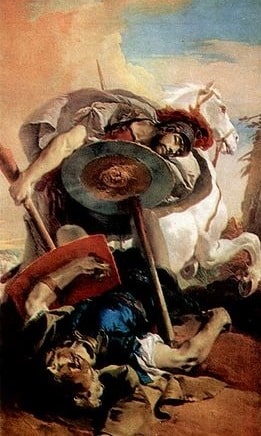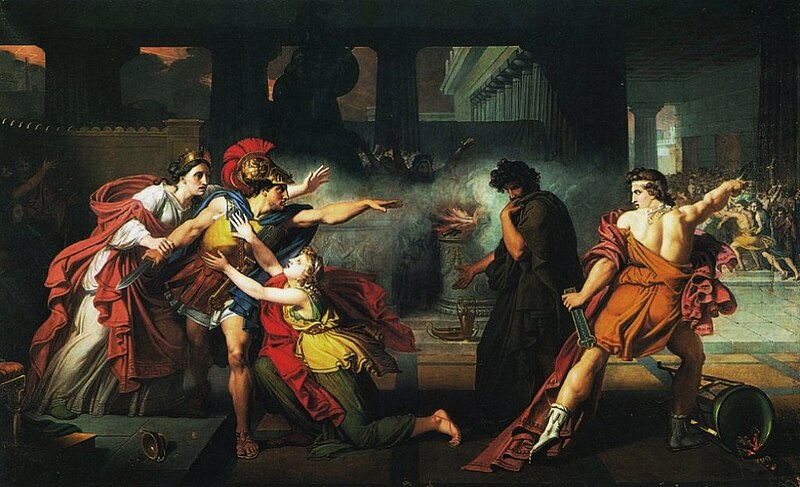In the vast tapestry of Greek mythology, few tales are as heart-wrenching as that of Eteocles and Polynices. These brothers, bound by blood yet torn apart by destiny, stand as a testament to the complexities of family ties and the tragic consequences of pride and ambition.
Eteocles and Polynices: Key Facts
| Parents | Oedipus and Jocasta |
| Partners | N/A |
| Siblings | Antigone and Ismene |
| Offspring | N/A |
| Other names | N/A |
| Roman name | N/A |
| Best Known Myth | The Seven Against Thebes |
Name and Etymology
The names Eteocles and Polynices have roots deeply embedded in the ancient Greek language. Eteocles, derived from the Greek words “etos” meaning true and “kleos” meaning glory, can be translated as “true glory.” On the other hand, Polynices, stemming from “poly” meaning many and “nike” meaning victory, translates to “much victory.”
These names, laden with meaning, foreshadow the brothers’ tumultuous relationship and their eventual tragic end. The Romans, while familiar with their tale, didn’t have distinct names for these brothers, often referring to them by their Greek monikers. Various epithets and alternate names exist, but these two remain the most recognized.

Eteocles and Polynices: Family and Relationships
Born to the ill-fated Oedipus and Jocasta, Eteocles and Polynices were destined for tragedy from the start. Their parents’ infamous relationship, marred by prophecies and misfortunes, cast a long shadow over their lives. As children, they witnessed the downfall of their father, Oedipus, and the subsequent exile that tore their family apart.
This tumultuous upbringing sowed the seeds of rivalry and discord between the brothers. While their romantic endeavors aren’t as prominently featured in myths, their relationships with other figures, such as Briseis, Menelaus, and Agamemnon, play pivotal roles in the larger narrative of the Trojan War.
Myths about Eteocles and Polynices
Greek mythology is rife with tales of heroism, betrayal, and tragic destinies, and the stories surrounding Eteocles and Polynices are no exception. Their narratives, deeply intertwined with the fate of Thebes, serve as a stark reminder of the perils of ambition and the complexities of familial ties.
The Oath and The Seven Against Thebes
The seeds of discord were sown when the brothers made a pact to share the throne of the ancient city of Thebes, ruling alternately each year. Eteocles took the first turn, but when his year concluded, his thirst for power became evident. He refused to step down, betraying the oath he had taken with Polynices. This act of treachery set the stage for one of the most epic confrontations in Greek mythology.
Polynices, feeling wronged and exiled, sought allies to reclaim his birthright. He rallied a formidable group known as the Seven Against Thebes. Among their ranks were many known heroes, each hero bearing a unique emblem on their shield, symbolizing their individual prowess. The city of Thebes braced itself for an onslaught, with Eteocles personally choosing champions to defend its seven gates. The climax of this tale is heart-wrenching: the brothers, in their fury and pride, faced each other in single combat. Eventually leading to their mutual demise.
The Burial Controversy
In death, the brothers’ tale did not find its conclusion. The aftermath of their duel saw Polynices branded a traitor, with a royal decree forbidding his burial. This decree set the stage for another iconic myth, that of their valiant sister, Antigone. Defying the edict of King Creon, Antigone believed in the divine right of every individual to receive proper burial rites. Her act of burying Polynices, and the tragic consequences that followed, underscored the moral dilemmas of duty, honor, and the laws of men versus the laws of the gods.
The Oracle’s Prophecy and The Curse of Oedipus
Their father, Oedipus, upon discovering his own tragic life’s events (marrying his mother and killing his father), cursed his sons. Leaving them prophesying that they would end up killing each other in a battle for Thebes. This curse, a recurring motif in their story, loomed over them, shaping their choices and destinies. Their tragic end can be seen as a fulfillment of this curse. A final testament to the inescapable nature of prophecies in Greek myths.
The Aftermath and Legacy
The deaths of Eteocles and Polynices left a power vacuum in Thebes, leading to further strife and conflict. Their tale served as a cautionary narrative about the dangers of unchecked ambition and the devastating consequences of familial discord.
Depiction And Characteristics
Eteocles and Polynices, in art and literature, are often portrayed as mirror images of each other, emphasizing their intertwined fates. Symbols associated with them include the city of Thebes and the emblematic shields of the Seven Against Thebes. Their personalities, as depicted in myths, are complex and often in opposition to each other. Eteocles is often seen as the more stubborn and power-hungry while, Polynices is portrayed as the wronged brother seeking justice. Yet, both are victims of their own ambitions, and their tragic end is a testament to their flawed characters.
Representations Of Eteocles and Polynices In Art
The brothers’ tragic tale has inspired countless artists throughout history. From ancient pottery showcasing their fierce duel to Renaissance paintings depicting their final moments, their story has been immortalized time and again. One notable artwork is the “Death of Eteocles and Polynices” by Giovanni Battista Tiepolo, where the brothers are depicted in their fatal embrace, capturing the raw emotion of their tragic end.

Mentions in Ancient Texts
Each offering a unique perspective on their tragic story. These works, provide invaluable insights into the brothers’ legacy and the cultural significance of their myths.
Aeschylus’ “Seven Against Thebes”
Aeschylus, a pioneering Greek tragedian from the 5th century BCE, is often hailed as the father of tragedy. In his play “Seven Against Thebes,” he delves deep into the brothers’ conflict over the Theban throne. Through poetic dialogues and dramatic sequences, Aeschylus paints a vivid picture of the siege of Thebes. Finally leading to the eventual confrontation between Eteocles and Polynices.
“Two men of one blood, leaders of the same army, having speared each other, lie dead, having achieved a common fate.”
Sophocles’ “Antigone”
Sophocles, another luminary from the golden age of Greek tragedy (circa 5th century BCE), offers a different lens to view the brothers’ tale through his play “Antigone.” While the brothers are central to the narrative, the focus here shifts to their sister, Antigone, and her defiance against King Creon’s decree. Sophocles, with his nuanced character development and exploration of moral dilemmas, brings to life the aftermath of the brothers’ deaths and the ethical questions surrounding burial rites.
Euripides’ “Phoenician Women”
Euripides, a contemporary of Sophocles and a master playwright of ancient Greece, presents yet another perspective in his work “Phoenician Women.” Written in the late 5th century BCE, this play delves into the events leading up to the brothers’ fatal duel. Euripides, known for his complex characters and innovative approach to myths, offers a more intimate look into the family dynamics of the House of Oedipus and the tragic consequences of their cursed lineage.
Statius’ “Thebaid”
Venturing beyond Greek sources, the Roman poet Statius, in the 1st century CE, penned an epic titled “Thebaid.” Spanning twelve books, this magnum opus chronicles the entire saga of Thebes, from the curse of Oedipus to the deaths of Eteocles and Polynices. Statius, with his rich descriptions and epic style, adds layers of depth to the tale, emphasizing the grandeur and tragedy of the Theban saga.
“By mutual wounds the brothers both alike / Were stretch’d in death, and breathed out their spiteful souls / Upon each other’s lips.”
Frequently Asked Questions
Eteocles refused to give up the throne of Thebes after his year of rule. This later led Polynices to wage war against him.
They were the sons of Oedipus and Jocasta.
Yes, they had two sisters, Antigone and Ismene.
The brothers killed each other in single combat during the war for Thebes.
Despite a decree forbidding his burial, his sister Antigone defied the order to give him proper rites.
Their relationships with figures like Briseis, Menelaus, and Agamemnon tie them to the larger narrative of the Trojan War.
Featured Image Credit: Church, Alfred J., Public domain, via Wikimedia Commons
